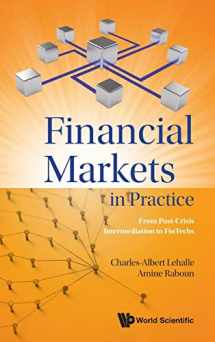
Financial Markets In Practice: From Post-crisis Intermediation To Fintechs
Book details
Summary
Description
About the Author
Currently Head of Data Analytics at Capital Fund Management (CFM, Paris) and visiting researcher at Imperial College (London), Charles-Albert Lehalle studied machine learning for stochastic control during his PhD 20 years ago. He started his career being in charge of AI projects at the Renault research center and moved to the financial industry with the emergence of automated trading in 2005. He became an expert in market microstructure and has been appointed Global Head of Quantitative Research at Crédit Agricole Cheuvreux, and Head of Quantitative Research on Market Microstructure in the Equity Brokerage and Derivative Department of Crédit Agricole Corporate Investment Bank after the crisis. He provided research and expertise on these topics to investors and intermediaries, and is often heard by regulators and policy-makers like the European Commission, the French Senate, the UK Foresight Committee, etc. He chairs the Index Advisory Group of Euronext, is a member of the Scientific Committee of the French regulator (AMF), and has been part of the Consultative Workgroup on Financial Innovation of the European Authority (ESMA). Moreover, Charles-Albert received the 2016 Best Paper Award in Finance from Europlace Institute for Finance (EIF) and published more than 50 academic papers and book chapters. He co-authored the book Market Microstructure in Practice (World Scientific Publisher, 2nd ed 2018), analyzing the main features of modern markets. He is chairing the "Finance and Insurance Reloaded" transverse research program of the Louis Bachelier Institute; this program explores the influence of new technologies (from blockchain to artificial intelligence) on our industries.
Amine Raboun holds a PhD in Finance from Université Paris Dauphine, PSL Research University. His research focuses on portfolio management, market frictions, and liquidity especially on the topics related to alternative risk premia, ESG, transaction costs, and crowding. Prior to his PhD, Amine graduated from Télécom ParisTech in 2016 with a specialization in Computer Science and Financial Engineering, before completing an MSc in Applied Mathematics at Ecole Polytechnique in 2017. Meanwhile, he interned at Kepler Cheuvreux and Capital Fund Management as a quantitative analyst. He currently holds the position of index structurer at Euronext.
Financial Markets in Practice: From Post-Crisis Intermediation to FinTechs delivers an overview of the development of risk-transformation undertaken by the financial services industry from the perspective of quantitative finance. It provides an instructional and comprehensive explanation of the structure of the financial system as a network of risk suppliers and risk consumers, where different categories of market participants buy, transform, net, and re-sell different kinds of risks. This risk-transformation oriented view is supported by the changes that followed the last global financial crisis: consumers of financial products asked for less complex risk transformations, regulators demanded limiting risks inside financial institutions to the maximum extent possible, and market participants turned to run mass market-like businesses and away from bespoke "haute couture"-like businesses. This book portrays the network of intermediaries that compose the financial system, describes their most common business models, explains the exact role of each kind of market participant, and underlines the interaction between them. It seeks to reveal the potential disintermediation that could occur inside the financial sector, led by FinTechs and Artificial Intelligence-based innovations. Readers are invited to reconsider the role of market participants in the post-crisis world and are prepared for the next wave of changes driven by data science, AI, and blockchain. Amid these innovations, quantitative finance will be increasingly involved in all aspects of the financial system. This handy resource


We would LOVE it if you could help us and other readers by reviewing the book
Book review



